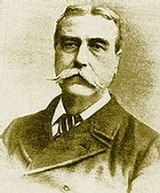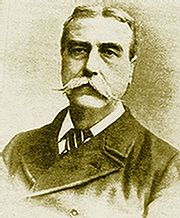
Robert D'Onston Stephenson
Encyclopedia

Writer
A writer is a person who produces literature, such as novels, short stories, plays, screenplays, poetry, or other literary art. Skilled writers are able to use language to portray ideas and images....
and journalist
Journalist
A journalist collects and distributes news and other information. A journalist's work is referred to as journalism.A reporter is a type of journalist who researchs, writes, and reports on information to be presented in mass media, including print media , electronic media , and digital media A...
, chiefly known for having been made a potential suspect
Suspect
In the parlance of criminal justice, a suspect is a known person suspected of committing a crime.Police and reporters often incorrectly use the word suspect when referring to the...
in the Jack the Ripper
Jack the Ripper
"Jack the Ripper" is the best-known name given to an unidentified serial killer who was active in the largely impoverished areas in and around the Whitechapel district of London in 1888. The name originated in a letter, written by someone claiming to be the murderer, that was disseminated in the...
investigation and for his personal theory as to the identity of the murderer.
Involvement
Mary Ann NicholsMary Ann Nichols
Mary Ann "Polly" Nichols was one of the Whitechapel murder victims. Her death has been attributed to the notorious unidentified serial killer Jack the Ripper, who is believed to have killed and mutilated five women in the Whitechapel area of London from late August to early November 1888.- Life...
, the first victim generally acknowledged to have been killed by 'Jack the Ripper'
Jack the Ripper
"Jack the Ripper" is the best-known name given to an unidentified serial killer who was active in the largely impoverished areas in and around the Whitechapel district of London in 1888. The name originated in a letter, written by someone claiming to be the murderer, that was disseminated in the...
, was found about 150 yards from the London Hospital, on 31 August 1888. Stephenson had been staying at the hospital since 26 July and left on 7 December. His profession, and his private studies of the 'occult sciences', made him take a more than average interest in the evolving murder series. At the London Hospital the murders were, as elsewhere, the major subject of conversation. After witnessing one Doctor Morgan Davies performing a demonstration of how the murderer may have been subduing and killing the victims, Stephenson found Davies' behaviour suspicious, and brought the story on, to one George Marsh, an ironmongery salesman professing to be an amateur detective. George Marsh, on his side, found Stephenson to be the more suspicious character, and went to the Scotland Yard
Scotland Yard
Scotland Yard is a metonym for the headquarters of the Metropolitan Police Service of London, UK. It derives from the location of the original Metropolitan Police headquarters at 4 Whitehall Place, which had a rear entrance on a street called Great Scotland Yard. The Scotland Yard entrance became...
. One of the officers, Inspector Roots, immediately recognized the suspect by description as being a man he had known for 20 years - Robert D'Onston Stephenson: "a travelled man of education and ability, a doctor of medicine upon diplomas of Paris and New York: a major from the Italian Army - he fought under Garibaldi: and a newspaper writer". From Roots's report it may seem that Stephenson was cleared of suspicion without further ado. According to Maxim Jakubowski
Maxim Jakubowski
Maxim Jakubowski is a crime, erotic, and science fiction writer and critic.Jakubowski was born in England to Russian-British and Polish parents, but raised in France. Jakubowski has also lived in Italy and has travelled extensively...
and Jonathan Braund "it appears that his (Stephenson's) cultured manner and eagerness to assist the police with arcane knowledge evoked their admiration rather than their suspicion".
Stephenson's interest in the crimes eventually led to an article in the Pall Mall Gazette
Pall Mall Gazette
The Pall Mall Gazette was an evening newspaper founded in London on 7 February 1865 by George Murray Smith; its first editor was Frederick Greenwood...
, presenting his own theory
Theory
The English word theory was derived from a technical term in Ancient Greek philosophy. The word theoria, , meant "a looking at, viewing, beholding", and referring to contemplation or speculation, as opposed to action...
about the motivation
Motivation
Motivation is the driving force by which humans achieve their goals. Motivation is said to be intrinsic or extrinsic. The term is generally used for humans but it can also be used to describe the causes for animal behavior as well. This article refers to human motivation...
and identity of the murderer, based upon the character of the crimes and a possible clue
Evidence
Evidence in its broadest sense includes everything that is used to determine or demonstrate the truth of an assertion. Giving or procuring evidence is the process of using those things that are either presumed to be true, or were themselves proven via evidence, to demonstrate an assertion's truth...
found in Goulston Street. According to Stephenson the murderer would have to be a practician of "black magic" as the parts removed from the victims bodies could be used for ritual purposes. Stephenson's theory also referred to a possible clue found in Goulston Street where, after the murder of Catherine Eddowes
Catherine Eddowes
Catherine Eddowes was one of the victims in the Whitechapel murders. She was the second person killed on the night of Sunday 30 September 1888, a night which already had seen the murder of Elizabeth Stride less than an hour earlier...
on 30 September, in Mitre Square
Mitre Square
Mitre Square is a small square in the City of London. It measures about by and is connected via three passages with Mitre Street to the SW, to Creechurch Place to the NW and, via St James's Passage , to Duke's Place to the NE....
, a piece of her bloodied apron was left under a sentence neatly written in chalk, at the entrance of a 'model dwelling' with Jewish tenants. A written copy was taken down, registering the writing as saying: "The Juwes are the men that Will not be Blamed for nothing". Two weeks later, on the 17 October, after noticing that the Chief Commissioner of the Metropolitan Police
Metropolitan police
Metropolitan Police is a generic title for the municipal police force for a major metropolitan area, and it may be part of the official title of the force...
, Sir
Sir
Sir is an honorific used as a title , or as a courtesy title to address a man without using his given or family name in many English speaking cultures...
Charles Warren
Charles Warren
General Sir Charles Warren, GCMG, KCB, FRS was an officer in the British Royal Engineers. He was one of the earliest European archaeologists of Biblical Holy Land, and particularly of Temple Mount...
, had been claiming that "no language or dialogue is known in which the word Jews is spelled JUWES", Stephenson wrote a letter to the City Police
City of London Police
The City of London Police is the territorial police force responsible for law enforcement within the City of London, England, including the Middle and Inner Temple. The service responsible for law enforcement within the rest of Greater London is the Metropolitan Police Service, a separate...
, claiming that a similar word did indeed exist.
Suspected
Stephenson later fell under the suspicion of newspaper editor William Thomas Stead
William Thomas Stead
William Thomas Stead was an English journalist and editor who, as one of the early pioneers of investigative journalism, became one of the most controversial figures of the Victorian era. His 'New Journalism' paved the way for today's tabloid press...
, the writer Mabel Collins
Mabel Collins
Mabel Collins was a theosophist and author of over 46 books.-Life:Mabel Collins was born in St Peter Port, Guernsey...
and her friend Baroness Vittoria Cremers
Vittoria Cremers
Vittoria Cremers was born Vittoria Cassini in Pisa, Italy in ca. 1859, the daughter of the Italian Manrico Vittorio Cassini and his British wife, Agnes Elizabeth Rutherford. She got married in Manhattan, New York on November 26, 1886, to the Russian Baron Louis Cremers, born in 1851 in St....
. Cremers told Aleister Crowley
Aleister Crowley
Aleister Crowley , born Edward Alexander Crowley, and also known as both Frater Perdurabo and The Great Beast, was an influential English occultist, astrologer, mystic and ceremonial magician, responsible for founding the religious philosophy of Thelema. He was also successful in various other...
that Stephenson was a doctor and had committed the Whitechapel murders as part of a magic ritual and that the sites of the murders, when joined together on a map, formed a calvary cross (which is untrue). The suspicion was not merely caused by Stephenson's preoccupation with "black magic". He had been, by his own account, in love with a prostitute, and had contracted venereal disease from others. The fact that Stephenson's wife seemingly disappeared in 1886 has led to the otherwise unsupported speculation that he may have killed her. According to Jakubowski and Braund, Stephenson claimed to have killed others, and that he was keeping ties stained with human blood, as well as being the owner of candles made from human fat. Collins and Cremers theory was later resurrected by Richard Whittington-Egan
Richard Whittington-Egan
Richard Whittington-Egan is a Liverpool-born writer and criminologist, the author of Liverpool Colonnade and Liverpool Roundabout, two colourful chronicles of Liverpool's historical characters, crimes and mysteries...
in A Casebook on Jack the Ripper and subsequently developed by the author Melvin Harris in Jack the Ripper: The Bloody Truth and its two sequels. Crime writer Colin Wilson
Colin Wilson
Colin Henry Wilson is a prolific English writer who first came to prominence as a philosopher and novelist. Wilson has since written widely on true crime, mysticism and other topics. He prefers calling his philosophy new existentialism or phenomenological existentialism.- Early biography:Born and...
praised the research done by Harris but concluded it didn't prove any connection between Stephenson and Jack the Ripper. Jakubowski and Braund state that the major problem with Stephenson as a suspect is that the idea is heavily reliant on his own testimony, both as to "the depth of his heartlessness and iniquity and as to his activities". Whilst Cremers, the principal witness, was closely linked to Aleister Crowley and Stephenson's "air of mystery and his somewhat theatrical, throwaway boast of wickedness" seem to anticipate Crowley's own romancing, the statements about blood and candles may have been theatrical props specifically designed to have the effect which they had - to frighten two impressionable women. Author Ivor Edwards also named Stephenson as the Ripper in his book, Jack the Ripper's Black Magic Rituals published by Penny Publishing (2001) and Blake Publishing (2002).
Further reading
- Melvin Harris, Jack the Ripper: The Bloody Truth (1987)
- Melvin Harris, The True Face of Jack the Ripper (2001)
- Ivor Edwards, Jack the Ripper's Black Magic Rituals (2001)

